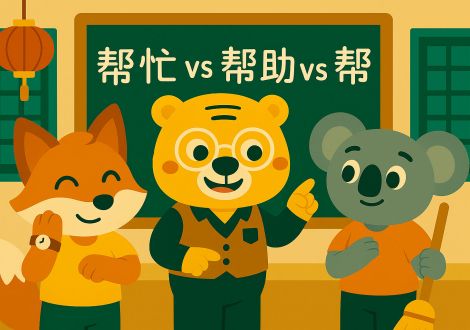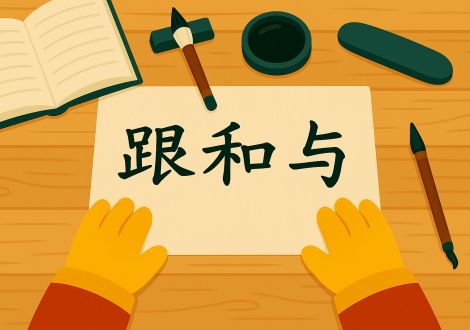One of the first things we learn when studying Chinese is how to say "and" or "with". But we soon find there are actually three different words that all seem to mean the same thing: 和 [hé], 跟 [gēn], and 与 [yǔ]. Can they be used interchangeably? Sometimes yes, but each has its own nuances, preferred uses, and contexts. Let's take a closer look!
跟 [gēn]: informal and conversational
Of the three words, 跟, is the most common in everyday conversation. As with the rest, it translates as "and" or "with," depending on the context. It usually connects personal pronouns. For example:
| Examples | ||
|---|---|---|
| hanzi | pinyin | meaning |
| 我跟他一起去看电影 | wǒ gēn tā yìqǐ qù kàn diànyǐng | I go with him to the cinema |
| 妈妈跟爸爸都喜欢旅游 | māma gēn bàba dōu xǐhuan lǚyóu | Both my mother and my father like to go travelling |
In both sentences, it would be interchangeable with 和.
跟 is also frequently used in the following structures:
| Examples | |
|---|---|
| structure | meaning |
| 跟 + somebody + 一起 [yìqǐ] + verb | to do something with somebody |
| 跟 + somebody/something + (不) 一样 [yíyàng] | to look like (when talking about two things or people) |
| 跟 + somebody/something + 有关系 [méi guānxi] | to be linked to something/somebody |
| 跟 + somebody + 说 [shuō] | to tell somebody something |
In the first two structures, we could also use 和. However, in the last two, only 跟 is correct.
和 [hé]: the most versatile
Unlike 跟, which you won’t usually see written down, 和 works in both written and spoken Chinese, making it the most versatile of the three prepositions. It is mainly used to connect two nouns, personal pronouns, or noun phrases. For example:
| Examples | ||
|---|---|---|
| hanzi | pinyin | meaning |
| 我喜欢苹果和香蕉 | wǒ xǐhuān píngguǒ hé xiāngjiāo | I like apples and bananas |
| 她每天都喝茶和咖啡 | tā měitiān dōu hé chá hē kāfēi | She drinks tea and coffee everyday |
In these two cases, we use 和 because we are listing nouns from the same category (fruit, drinks...). We wouldn’t use 跟 because this usually connects people instead.
It’s important to note that 和 can connect both nouns and personal pronouns, but not phrases that use different verbs. Let's look at an example of this in action:
| Examples | ||
|---|---|---|
| hanzi | pinyin | meaning |
| ❌ 他去了学校和买了东西 Incorrect | tā qù xuéxiào hé mǎi le dōngxī | He went to the school and to buy some things |
| ✅ 他去了学校,还买了东西 Correct: We use 还 or 也, not 和 | tā qù xuéxiào, hái mǎi dōngxi | He went to the school and to buy some things |
与 [yǔ]: formal and literary
Although 与 appears in higher HSK levels, we find it appropriate to mention it, as it’s easy to use, and it also means "and" or "with". However, it is much more formal and is usually found in legal, academic, literary, and journalistic texts. Here’s a good example:
| Example | ||
|---|---|---|
| hanzi | pinyin | meaning |
| 他与公司签订了合同 | tā yǔ gōngsī qiāndìng le hétóng | He signed a contract with the company |
And here’s how you wouldn’t use it:
| Example | ||
|---|---|---|
| hanzi | pinyin | meaning |
| ❌ 我与你去吃饭 | wǒ yú nǐ qù chīfàn | I’ll go to lunch with you |
Although grammatically correct, it would sound too serious and old-fashioned for everyday conversation.
Exercises
Complete the following sentences with 和, 跟 or 与 (there may be more than one correct option):
- 我朋友今年去北京______上海旅行。
- 我______妈妈去超市。
- 这件事___我没关系。
- 公司______外国公司合作。
- 我______朋友一起学习汉语。
- 我___你一起去图书馆,好吗?
- 小明___他妹妹都很聪明。
- 衬衫___裙子有点儿贵。
Answers:
- 和
- 跟/和
- 跟
- 与
- 跟/和
- 和/跟
- 和/跟
- 和





